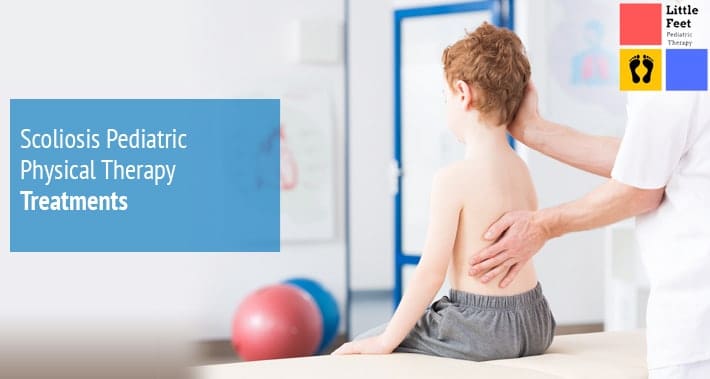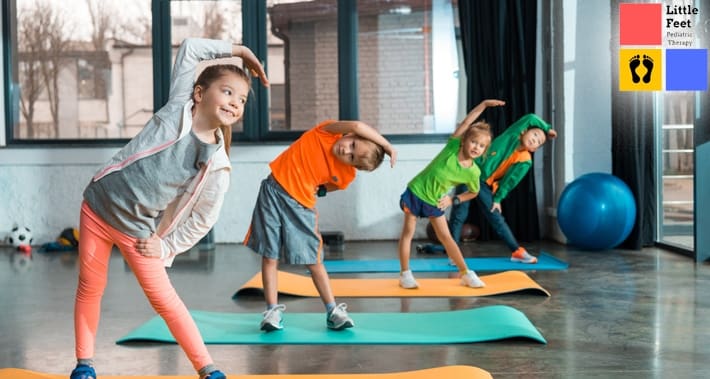
Scoliosis is a spinal condition that involves atypical curving in the spine.
Scoliosis can be present at birth, develop over time due to illness or injury, or develop for unknown reasons.
If your child’s spine is shaped like an ‘S’, a ‘C’, or curves sideways away from their midline, they may have scoliosis.
While back braces, surgery, and limited mobility are often associated with scoliosis, this isn’t always the case.
While your child’s treatment plan and prognosis depend on many factors, physical therapy for kids is an important part of slowing the progression of scoliosis.
Keep reading to find out more about scoliosis and how physical therapy can improve and maintain your child’s spinal health.
What Is Scoliosis?
Scoliosis is an atypical curvature of the spine.
Most spines have a slight curve forward, toward the chin, at the top of the shoulders and a slight curve back at the lower back.
If your child’s spine curves like an “S” or a “C”, or if it curves from side to side, they may have scoliosis.
Scoliosis can be mild, moderate, or severe.
Mild cases of scoliosis can be easy to miss.
A curvature of 10 to 20 degrees is considered mild scoliosis.
This degree of curvature in the spine may not be visible without measurement or imaging.
Your child might show only a slight unevenness in their posture and intermittent or very mild symptoms.
General strength training and conditioning exercises can sometimes be enough to adjust the spine in mild childhood cases.
Moderate scoliosis involves a spinal curvature of 20 to 40 degrees and has some impact on everyday activities.
Treatment for moderate scoliosis might involve fitting your child with an orthotic brace to slow down or prevent more curving of their spine.
Physical therapy can help build strength and mobility so that your child can maintain the changes created by bracing.
If left untreated, moderate scoliosis can become severe over time.
A spinal curvature of 40 to 45 degrees is considered severe and may be accompanied by pain and a lot of limits in activity.
Severe scoliosis is sometimes treated with surgeries that straighten and fuse the spine.
Physical therapy is an essential part of recovery, flexibility, pain management, and general wellbeing after surgery.
Healthcare professionals will use additional categories to figure out how to treat your child’s scoliosis effectively.
Your child’s scoliosis can be classified according to cause and type, in addition to severity.
Scoliosis categories by cause:
- Idiopathic – cases with no clear cause
- Congenital – cases of spinal issues present from birth
- Neurological – cases where nerve issues affect spinal muscles
Most cases of childhood scoliosis are idiopathic, meaning doctors don’t know what has caused the spine to curve.
Idiopathic scoliosis is most common in adolescents between age 10 and 18.
Congenital and neurological scoliosis can often be diagnosed in children 7 and under.
Scoliosis categories by type:
- Structural – permanent curving of the spine caused by disease, injury, or a condition present from birth
- Nonstructural – temporary curving that can be corrected
What Are The Symptoms of Scoliosis?
But how do you know if your child is exhibiting signs of scoliosis?
The telltale sign is curvature of their spine.
But that’s not always the most obvious sign.
Some common symptoms to watch out for in your child include:
- Their head not centered over their body
- One of their shoulders is higher than the other
- One of their shoulders sticks out more than the other
- Difficulty with deep breathing
- Their rib cage tilts up on one side
- Their shoulders, waist, and hips don’t align when standing
- Uneven hips
- Back pain
- Their body tilts or leans to one side
What Is The Main Cause Of Scoliosis?
Your child’s spine is made up of a series of stacked bone segments called vertebrae.
Scoliosis is the name health care workers use when your child’s vertebrae are not stacking up evenly, one on top of the other.
Scoliosis can be structural or nonstructural – also known as functional scoliosis.
Structural Scoliosis
Structural scoliosis means there is a curve in the way your child’s spine stacks up because of the shape of their vertebrae.
Picture two stacks of books.
One is a set of novels, the other a set of three ring binders like the ones you used in school.
The novels stack up pretty easily because they’re flat.
Each novel is one consistent height all the way across.
The binders, on the other hand, are wedge shaped.
They’re taller along the side with the rings, shorter on the open end.
When stacked in the same direction, one on top of the other, the binders tilt and slide.
When all or some of your child’s vertebrae are uneven in thickness, their spine stacks up with a curve, like the binders.
Nonstructural Scoliosis
Nonstructural, or functional, scoliosis happens when the muscles that support your child’s vertebrae are not strong enough.
A plant wilts when its stem doesn’t contain enough water to keep all its cells plump and firm.
When your child’s spinal muscles don’t have the strength to keep the spine aligned, their spine will wilt in a similar way.
What Do They Have In Common?
In both structural and nonstructural scoliosis, the curve in your child’s spine can put more pressure on the vertebrae.
This pressure can lead to wear and tear that can make scoliosis more severe and cause pain down the road.
But what causes uneven vertebrae or weakened muscles in the first place?
Most cases of scoliosis are idiopathic, meaning doctors are unable to identify a reason for the state of the spine.
Scoliosis is more common in girls than boys.
A family history of scoliosis also increases the chances of a child developing scoliosis.
When it is possible to identify a cause, the most common causes are conditions present from birth, nerve issues, or genetics.
Common health issues that have been linked with scoliosis include:
- Cerebral palsy
- Spina bifida and other conditions that affect bone development
- Muscular dystrophy, a group of genetic conditions that lead to weak muscles
- Spinal injuries during birth
- Toe walking
- An infection that damages the spine

Can Scoliosis Be Cured?
Currently, there is no known cure for scoliosis.
But there is still help available.
In some cases, scoliosis can be significantly slowed down and symptoms can be well managed with treatment.
Mild scoliosis can be effectively treated with exercise, preventing pain and effects on other parts of your child’s body.
If your child has severe scoliosis, surgical treatments may reduce some symptoms.
Although researchers are working on it, currently no known treatments can make vertebrae grow back once they’re worn down.
In nonstructural cases with limited spinal wear and tear physical therapy can prevent progression and complications.
A Physical Therapy Approach For Kids With Scoliosis
The ‘wait and see’ approach is common for pediatric scoliosis, especially in mild cases.
This approach is a gamble that could mean your child loses out in the future.
The stress that scoliosis places on their spine can lead to more severe scoliosis in the future.
Over time, misalignment can lead to stress, wear and tear, and growth complications in other parts of your child’s body.
This is why early intervention pediatric therapy is so important.
Physical therapy is minimally invasive, minimally painful, and can mean a future with fewer health challenges for your child.
Physical therapy approaches to childhood scoliosis typically focus on strength, range of motion, and posture.
Your physical therapist will take your child’s history and perform physical tests before creating a treatment plan.
Every child is different, and every plan is unique.
But in general, your child’s pediatric therapist may include the following:
1. Exercises To Improve Strength
Your child’s physical therapist can build strength in key muscle groups to support the spine and protect other bones and joints.
Muscle groups to focus on to improve scoliosis can include:
- Core
- Spinal muscles
- Hips
- Shoulders
- Head
- Feet
2. Exercises to Improve Range Of Motion
Curves in the spine and the structural imbalances they can produce may lead to limits in your child’s range of motion.
In physical therapy, range of motion exercises can help to restore or improve functional limits.
Range of motion exercises can both increase your child’s ability to move and teach them new ways to perform various functions.
Your child will be able to explore movements they haven’t been able to complete before and develop new physical skills.
3. Exercises To Improve Posture
A physical therapist can also work with your child to improve their posture awareness and build a more aligned posture.
Posture exercises help improve your child’s balance, coordination, strength, and flexibility, and can help strengthen the spinal muscles.
Posture is also an important way to prevent further damage or injury, as it reduces stress on ligaments, muscles, and joints.
Book Your Appointment With Little Feet Pediatric Therapy Today
Are you constantly reminding your child to correct their posture?
Does your child complain of back pain?
Childhood scoliosis can lead to physical pain and emotional stress in adolescence and adulthood.
Physical therapy can help your child understand their body better and move with less pain and more freedom.
Book your appointment with Little Feet Pediatric Therapy today.
► 3535 Randolph Rd, Charlotte, NC 28211
► 1331 H St NW Ste 200, Washington, DC 20005
► St. Louis, MO
► Raleigh, NC
Founded in 2019, Little Feet Therapy offers on site pediatric physical and occupational therapy treatments for children from 2 months to 18 years old with physical and developmental concerns. Our clinics focus on providing therapy in a child’s natural setting where your child is in familiar surroundings, it puts their mind at ease and helps them focus more on the work they’re doing with their pediatric therapist. Our therapists will work with your child at your home, at school, at daycare, or another place in the community where they feel most comfortable.